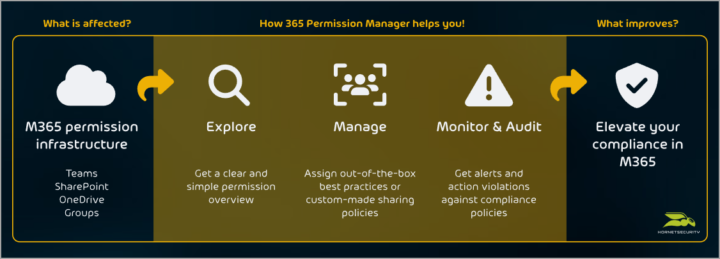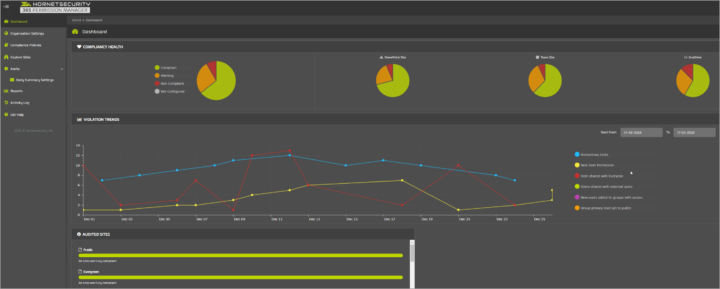Microsoft 365 (M365) is a powerful platform that offers many benefits for businesses, such as increased productivity, collaboration, and security. However, managing permissions and compliance in M365 can be challenging and time-consuming, especially when dealing with complex and dynamic environments that involve multiple apps, locations, and users. That’s why Hornetsecurity has developed 365 Permission Manager, a user-friendly, admin-centered solution that simplifies and automates permission management and compliance enforcement in M365.
With 365 Permission Manager, you can easily monitor, control, and audit the sharing and access of your sensitive data across SharePoint, Teams, and OneDrive, and ensure that your organization meets the regulatory and internal requirements.
In this blog post, we will explore how 365 Permission Manager can help you build a game-winning strategy for M365 compliance, by providing you with the following capabilities:
- Simplify managing permissions at scale
- Take back control with compliance policies
- Receive alerts for critical shares
- Take quick actions
- Achieve effective compliance with our GRC service
- Receive comprehensive reporting
Simplify managing permissions at scale
One of the main challenges of M365 compliance is keeping track of who has access to what, and why. With 365 Permission Manager, you can get a clear and comprehensive overview of all the permissions and shares in your M365 environment, and easily manage them from a single dashboard. You can see which sites, files, and folders are shared internally or externally, and with whom, and filter them by various criteria, such as owner, type, or date. You can also perform bulk actions, such as adding, removing, or changing permissions, and export the data for further analysis.
Take back control with compliance policies
Another challenge of M365 compliance is ensuring that your data is shared and accessed according to your organization’s policies and standards. With 365 Permission Manager, you can define and enforce compliance policies for your M365 data, and prevent unauthorized or inappropriate sharing. You can choose from out-of-the-box best practice policies, or create your own custom policies, and apply them at the site, folder, or file level. You can also monitor the compliance status of your data, and identify and remediate any policy violations.
Receive alerts for critical shares
A third challenge of M365 compliance is detecting and responding to potential risks and threats that may arise from data sharing. With 365 Permission Manager, you can receive real-time alerts for critical shares, such as anonymous links, external shares, or shares with specific domains or users. You can also configure the alert settings, such as the frequency, recipients, and severity, and take immediate actions, such as revoking or modifying the share, or notifying the owner.
Take quick actions
A fourth challenge of M365 compliance is taking timely and effective actions to protect your data and maintain compliance. With 365 Permission Manager, you can take quick actions from the dashboard, such as revoking, modifying, or extending permissions, or sending reminders or requests to the owners or users. You can also automate actions, such as expiring or deleting shares, or applying policies, based on predefined rules or triggers.
Achieve effective compliance with our GRC service
A fifth challenge of M365 compliance is achieving and demonstrating compliance with various regulations and standards, such as GDPR, HIPAA, or ISO 27001. With 365 Permission Manager, you can leverage our GRC service (Governance, Risk, and Compliance) to assess and improve your compliance posture, and provide evidence to auditors and stakeholders. You can use Compliance Manager, a tool that translates complex regulatory requirements into specific controls and provides a quantifiable measure of compliance through compliance score. You can also use eDiscovery, a tool that helps you manage the end-to-end workflow of internal and external investigations, and collect and preserve relevant data.
Receive comprehensive reporting
A sixth challenge of M365 compliance is generating and maintaining accurate and up-to-date reports on your data sharing and compliance activities. With 365 Permission Manager, you can receive comprehensive reporting on various aspects of your M365 environment, such as permissions, shares, policies, alerts, actions, and compliance score. You can also customize the reports, such as the format, content, and frequency, and export or share them with others.
Check the upcoming webinar about How 365 Permission Manager Builds a Game-Winning Strategy for M365 Compliance
Register HERE – The webinar is scheduled for 30th January 2PM EST
Conclusion
M365 compliance is a complex and critical task that requires a lot of attention and effort from admins and users. With 365 Permission Manager from Hornetsecurity, you can simplify and automate this task, and gain more visibility, control, and security over your M365 data. You can also achieve and demonstrate compliance with various regulations and standards, and reduce the risks and costs associated with data breaches and non-compliance.
If you want to learn more about 365 Permission Manager, or request a free trial, visit Hornetsecurity’s website
More about Hornetsecurity on ESX Virtualization Blog:
- Hornetsecurity’s 365 Threat Monitor for Microsoft 365 Review
- Hornetsecurity VM Backup V9 for VMware vSphere and Microsoft Hyper-V – Product Review
- The Importance of Security Awareness Training to successfully fight Ransomware
More posts from ESX Virtualization:
- VMware vCenter Server 8.0 U1b resolves further upgrade issues and adds bunch of security patches
- VMware vCenter Server Appliance 8.0U1a Released
- Homelab v 8.0 (NEW)
- vSphere 8.0 Page (NEW)
- Veeam Bare Metal Recovery Without using USB Stick (TIP)
- ESXi 7.x to 8.x upgrade scenarios
- A really FREE VPN that doesn’t suck
- Patch your ESXi 7.x again
- VMware vCenter Server 7.03 U3g – Download and patch
- Upgrade VMware ESXi to 7.0 U3 via command line
- VMware vCenter Server 7.0 U3e released – another maintenance release fixing vSphere with Tanzu
- What is The Difference between VMware vSphere, ESXi and vCenter
- How to Configure VMware High Availability (HA) Cluster
Stay tuned through RSS, and social media channels (Twitter, FB, YouTube)



